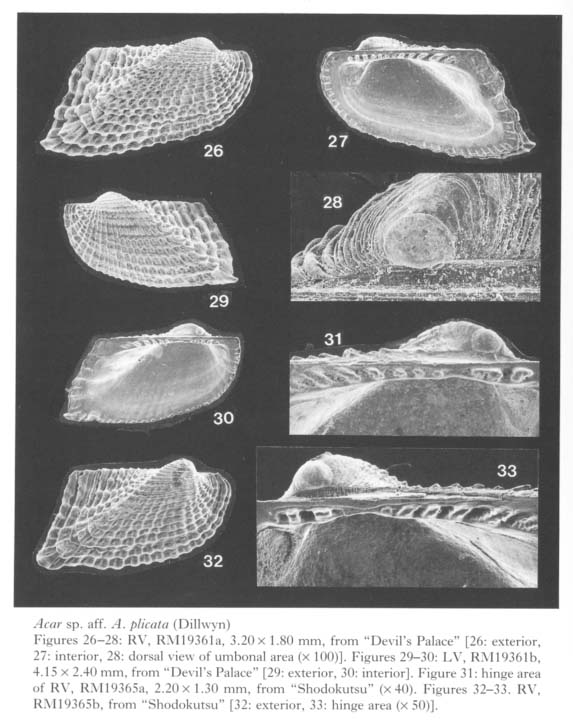Genus Acar Gray, 1857
Acar sp. aff. A. plicata (Dillwyn)
Figures 26-33

1992. Bentharca? sp. A, Kase and Hayami, Jour. Moll. Studies, vol.58, p.448, listed.
Material.—RM19361 (dead) from "Devil's Palace", RM19362 (dead) from "Fool's Palace", RM19363 (dead) from "Witch's House", RM19576 (dead) from "Toriike", RM19364 (dead) from "Black Hole" of Shimoji Islet. RM19365 (dead) from "Shodokutsu" of Ie Islet. Living specimens have not been found.
Description.—Shell small, variable in outline but commonly subtrapezoidal, white and opaque, elongate transversely, about 1.7 times longer than high, comparatively thick, strongly carinated. Dorsal margin truncated obtusely by nearly straight posterior margin. Anterior part reduced. Ventral margin nearly straight, with indistinct byssal indentation. Umbo prosogyrous, incurved, situated about one-fifth of dorsal margin from the anterior end. Flank except for umbonal area reveals strongly cancellate sculpture, which consists of about 17 radial ribs and commarginal lamellae of subequal prominence, producing nodes at intersections and spinose projections on posterior carina. Posterior area triangular and depressed, with four or five strong upward-curving ribs angularly abutting against posterior carina. Ventral and posterior margins strongly crenulated internally in accordance with external ribs, although crenulations are weakened in the antero-median part of ventral margin. Cardinal area moderate in breadth, with vertical striations and a vestige of alivincular ligament. Dentition consists of 2-3 small prosoclinal anterior teeth and 6-7 short opisthoclinal posterior teeth. Two or three posteriormost teeth strongly crenulated. Hinge plate leaves wide edentulous areas near anterior and posterior ends, Pd I large, D-shaped, nearly smooth, ranging 170-196 µm in maximum diameter; Pd II not discriminated.
Remarks.—This species differs from other cave arcids in the thicker shell, well-developed cancellate sculpture, strong marginal crenulations. The outline and sharp posterior carina of these specimens more strongly resemble those of Acar congenita (Smith, 1885) than Acar plicata (Dillwyn, 1817). A. congenita has been recorded from deeper waters than A. plicata, but some authors regarded them as conspecific. Because A. plicata commonly occurs outside the caves of this region, the possibility of ecophenotypic effect is not necessarily ruled out for the cave specimens. Some specimens from "Shodokutsu" (e.g. Figure 32) reveal a narrower umbonal area in comparison with the specimens from the Shomoji caves, but the difference may be attributable to intraspecific variation.
The adult size of this species is still obscure, because somewhat larger specimens occur in the cave sediments of Bohol and Palau. We assume that the present specimens represent stunting populations of Acar plicata adapted to cavernicolous environments.
Distribution.—Common in several sublittoral caves of Ie and Shimoji Islets of Ryukyu Islands. According to our preliminary survey, this species also occurs in "Balicasag cave" off Panglao Islet of Bohol Island, the Philippines, and "Chandelier Cave" near Koror of Palau Islands.